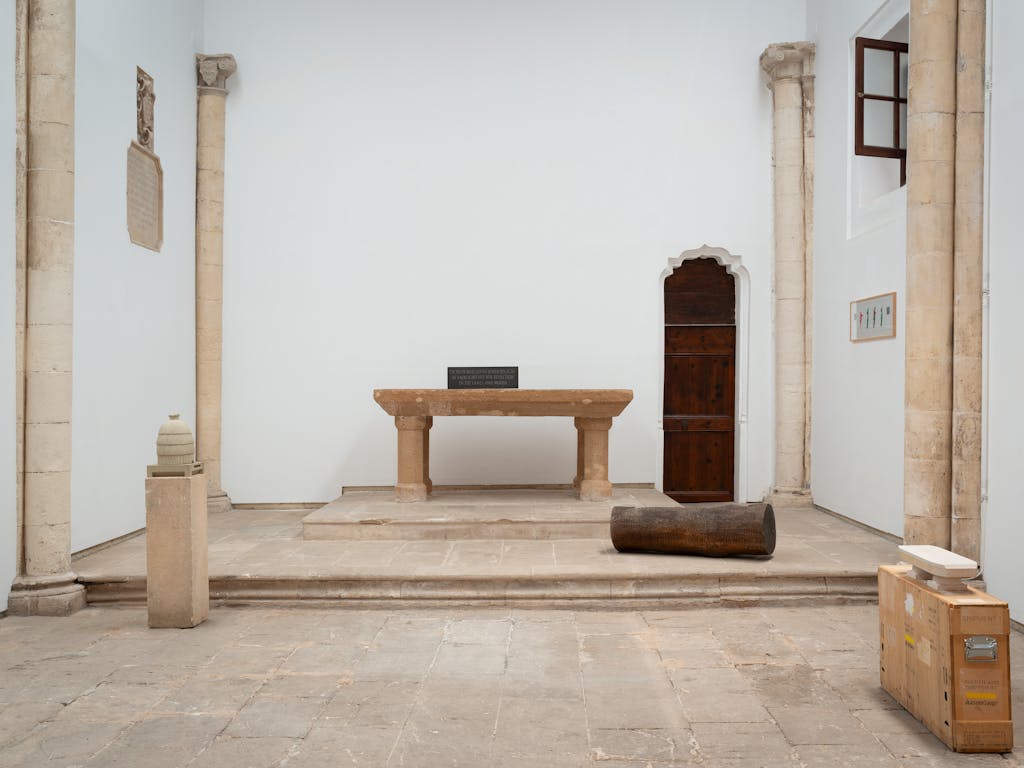IAN HAMILTON FINLAY
FRAGMENTS
8 May 2025 - 19 Jul 2025
Palma

In 2025, the centenary of Scottish artist and poet Ian Hamilton Finlay is being marked in a way that reflects the very structure of his life’s work: layered, distributed, and full of resonances. Titled Fragments, this ambitious international exhibition unfolds simultaneously across eight galleries in Europe and the United States, each presenting a distinct yet interwoven chapter of Finlay’s radical, poetic universe.
Curated by Pia Maria Simig, Fragments is not a retrospective in the traditional sense. Instead, it offers a constellation of encounters—sculptures, poems, neons, tapestries, and assemblages—allowing Finlay’s recurring themes to reverberate across time and space. His enduring concerns—classical antiquity, revolution, language, violence, nature, and the sea—are reimagined through the lenses of Ingleby Gallery, Edinburgh; Victoria Miro, London; David Nolan Gallery, New York; Sfeir-Semler, Hamburg; Galerie Hubert Winter, Vienna; KEWENIG, Palma de Mallorca; Galleria Massimo Minini, Brescia and Galerie Stampa, Basel.
At the heart of Fragments is Finlay’s unique way of working with language—not just as content, but as material. For him, a single word carved in stone or wood, cast in bronze, or illuminated in neon could carry immense weight. Across all eight venues, visitors encounter the many dualities that define Finlay’s practice: war and peace, beauty and brutality, the classical and the contemporary, the pastoral and the political.
Though deeply rooted in Scotland, Finlay’s work resists national borders. His garden at Little Sparta, perhaps his most famous creation, is echoed in these gallery spaces as a fragmented, conceptual landscape. The exhibition doesn’t seek to unify Finlay’s legacy into a neat narrative; instead, it embraces its contradictions, silences, and radical clarity.
Accompanying the exhibition is a richly illustrated publication, Fragments, which brings together Finlay’s own writings alongside new essays by Stephen Bann, Tom Lubbock, and others. This book, like the exhibition itself, resists closure—inviting new interpretations, new provocations, and renewed attention to a body of work that continues to speak, in carved stone and flickering neon, to the urgencies of our time.
In a world saturated with noise, Fragments reminds us of the power of brevity, the danger of beauty, and the quiet authority of words well placed.
JE VOUS SALUT MARAT, 1989
A window in the architect Corbusier’s Ronchamps Chapel bears the words ‘Je vous salue Marie’ rendered more or less in the manner of this neon. According to the Revolutionary Cathecism good Jacobins should ‘have no other god than Marat’. How could a Revolution which based itself on the writings of Rousseau be other than religious? – Ian Hamilton Finlay
AIRCRAFT CARRIER ALTAR, 1984
The Stoic philosopher Chrysippus wrote: The existence of the gods can be proven by the existence of altars. (Third proof of the existence of the gods.)
The second proof arises from “the variety and beauty of celestial phenomena... the power and grandeur of the seas and lands.”
If one combines these two proofs, it is not far-fetched to replace the altar with the aircraft carrier: it has the appearance of a giant altar (essentially a flat surface that absorbs light); it embodies the “power and grandeur of the seas and lands” — that is, it is a heroic construction which, if encountered without explanation, would surely suggest a “divine” inspiration.
(The argument that gods exist because people worship them might seem naïve at first glance, but it stems from the Stoic assumption of a unity between humankind and nature: things must fit together.)
...
(There is an implicit, alternative thought that jet planes — modern fighter aircraft — may be equated either with gods, or with cherubim surrounding the altar, or with servants or messengers of the gods.)
— Ian Hamilton Finlay (Letter to John Andrew)
JULIE INSCRIPTION, 1988
On it are carved three fragments of music-stave. One reads, with letters standing for notes, JULIE; another deciphers their rise and fall into pitches, scored for flute. The line of accompaniment, entirely rests, is to be performed by roses, rooted while the flautist has the power to move. The referent in Julie’s Garden in Rousseau’s Nouvelle Héloïse; and the smell of roses inaudibly turning into sound.
— Ian Hamilton Finlay, Works in Europe 1972-1995
ECHO AND NARCISSUS, 1989
“In vain Narcissus loved his echo. In vain Echo left her reflection in the caves and woods”
These particular lines capture the poetic reimagining of Ian Hamilton Finlay – merging myth of Ovid’s Echo and Narcissus; wordplay and art in minimalist dosage.
TEMPLA QUAM DILECTA, 1982
“Templa quam dilecta” means “How beautiful are your temples”, it is a phrase from the Psalms.